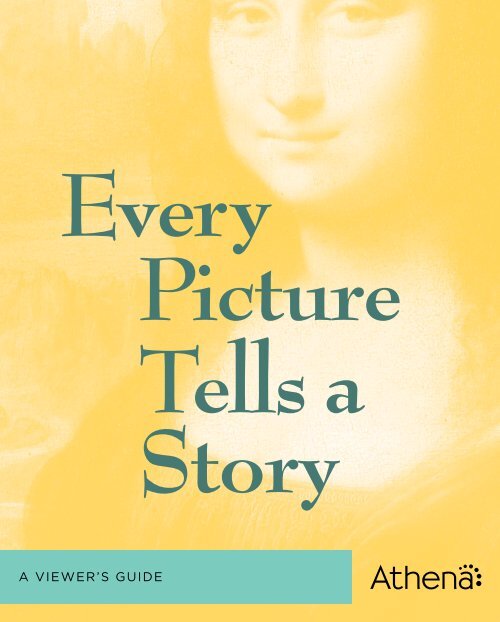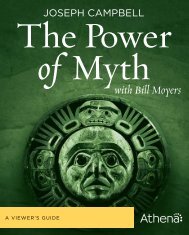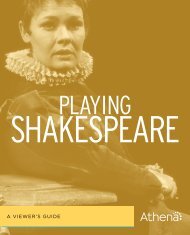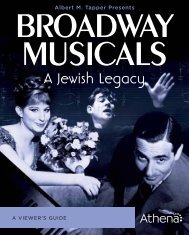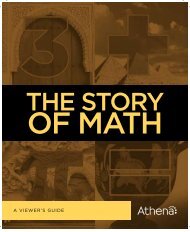Every Picture Tells a Story - Athena - Engage Your Mind
Every Picture Tells a Story - Athena - Engage Your Mind
Every Picture Tells a Story - Athena - Engage Your Mind
You also want an ePaper? Increase the reach of your titles
YUMPU automatically turns print PDFs into web optimized ePapers that Google loves.
<strong>Every</strong><br />
<strong>Picture</strong><br />
<strong>Tells</strong> a<br />
<strong>Story</strong><br />
a viewer’s guide
ca. 1750 (oil on canvas)<br />
National Gallery, London<br />
EpisodE 1<br />
Mr and Mrs Andrews<br />
by Thomas Gainsborough<br />
Highlights<br />
In his portrait of two aristocratic 18th-century British landowners,<br />
Gainsborough may have intended to depict bird carcasses in the<br />
unfinished area in the lady’s lap as a not-so-subtle comment on the<br />
couple’s marriage and social position.<br />
Questions to Consider<br />
1. Does the painting appeal to you? Why do you think critics consider it<br />
a masterpiece?<br />
2. Other critics have speculated that the artist could have intended to<br />
paint a child’s portrait or book in the void in Mrs. Andrew’s lap. What<br />
significance do you think those objects would have had? Why else<br />
might Gainsborough have left the area unfinished?<br />
3. If Mr. and Mrs. Andrews did indeed stop Gainsborough from<br />
including a symbolic social critique in the painting, how do you think<br />
the incident could have affected his ability to get commissions to<br />
paint the celebrities of his day?<br />
Other works Featured<br />
Mary, Countess Howe (ca. 1763), Thomas Gainsborough<br />
Mrs Sarah Siddons (1785), Thomas Gainsborough<br />
William Poyntz (1762), Thomas Gainsborough<br />
Thomas Gainsborough with His Wife and Elder Daughter, Mary<br />
(ca. 1751), Thomas Gainsborough<br />
Two Daughters with Cat (ca. 1759), Thomas Gainsborough<br />
Peter Darnell Muilman, Charles Croake, and William Keable in a<br />
Landscape (ca. 1750), Thomas Gainsborough<br />
Girl with Pigs (1782), Thomas Gainsborough<br />
The Four Elements: Air (1570), Joachim Beuckelaer<br />
1
1632 (oil on canvas)<br />
Mauritshuis, The Hague<br />
EpisodE 2<br />
The Anatomy Lesson of Dr. Tulp<br />
by Rembrandt<br />
Highlights<br />
Rembrandt suggests Christian iconography in his portrait of a<br />
criminal’s cadaver and puts us, the viewers, in the position of the<br />
audience often depicted in such paintings.<br />
Questions to Consider<br />
1. Why do you think the 17th century Dutch were so fascinated by<br />
cadaver dissections?<br />
2. What elements of the painting appeal to you? In your opinion, what<br />
identifies it as a Rembrandt?<br />
3. Do you think the fascination with dissection has any parallels in<br />
modern painting, photography, or film? Why or why not?<br />
Other works Featured<br />
Self Portrait as the Apostle St. Paul (1661), Rembrandt<br />
The Descent from the Cross (1633), Rembrandt<br />
Flayed Ox (1655), Rembrandt<br />
Dead Peacocks (ca. 1639), Rembrandt<br />
Anatomy drawing from the Leiden Anatomy Theatre (1609),<br />
J.C. Woudanus<br />
The Anatomy Lesson of Dr. Sebastiaen Egbertszoon (ca. 1601-03),<br />
Aert Pieterszoon<br />
Dr. Sebastiaen Egbertszoon’s Osteological Presentation (1619),<br />
Nicolaes Eliaszoon Pickenoy<br />
The Anatomy Lesson of Dr. Frederick Ruysch (1683), Jan van Neck<br />
Self Portrait (1628), Rembrandt<br />
Still Life with Flowers (1639), Hans Bollongier<br />
The Night Watch (1642), Rembrandt<br />
The Anatomy Lesson of Dr. Joan Deyman (1656), Rembrandt<br />
3
ca. 1505 (oil on canvas)<br />
Galleria dell 'Accademia, Venice<br />
EpisodE 3<br />
The Tempest<br />
by Giorgione<br />
Highlights<br />
In The Tempest, Giorgione depicts the ancient Greek story of the<br />
goddess Demeter and her mortal lover Iasion, whom Zeus struck<br />
down with a lightning bolt.<br />
Questions to Consider<br />
1. How do you react to the painting on a personal level?<br />
2. What elements of the painting give it such a “charged” atmosphere?<br />
3. In some versions of the Greek myth, Iasion and Demeter’s dalliance<br />
produced not one, but two sons—Plutus (god of wealth) and<br />
Philomelus (who invented the plough). How does this version<br />
influence the interpretation of the painting?<br />
Other works Featured<br />
Sleeping Venus (ca. 1510), Giorgione<br />
Judith (ca. 1504), Giorgione<br />
Laura (1506), Giorgione<br />
Three Philosophers (ca. 1508/09), Giorgione<br />
The Vendramin Family (mid 1540s), Titian<br />
Miracle of the True Cross at the Bridge of San Lorenzo (1500),<br />
Gentile Bellini<br />
Portrait of Lord Byron in Albanian Dress (ca. 1835), Thomas Phillips<br />
Feast in the House of Levi (1573), Paolo Veronese<br />
Danae (ca. 1560), Titian<br />
Diana and Callisto (1556-59), Titian<br />
Jupiter and Io (1532), Antonio da Corregio<br />
Rape of Ganymede (1635), Rembrandt<br />
5
ca. 1485 (tempera on canvas)<br />
Uffizi Gallery, Florence<br />
EpisodE 4<br />
The Birth of Venus<br />
by Botticelli<br />
Highlights<br />
Botticelli depicts Venus not as a primarily erotic figure, but as a<br />
symbol of fertility.<br />
Questions to Consider<br />
1. What do you appreciate most about The Birth of Venus?<br />
2. Have you seen the painting elsewhere in popular culture? Does that<br />
impact your experience of the painting?<br />
3. Januszczak draws many clues for his interpretation from the house<br />
where the Venus hung and other paintings located there. To what<br />
extent should context influence our interpretation of art? Have you<br />
ever changed your views of a piece of art, literature, or film upon<br />
learning its context?<br />
4. How much weight do you give to symbols when evaluating or<br />
appreciating a work of art?<br />
Other works Featured<br />
Adoration of the Magi (1475), Botticelli<br />
Fortitude (ca. 1470), Botticelli<br />
Madonna of the Pomegranate (ca. 1487), Botticelli<br />
Madonna of the Magnificat (ca. 1481), Botticelli<br />
The Adoration of the Magi (ca. 1478/82), Botticelli<br />
Portrait of a Man with Medal of Cosimo the Elder (ca. 1474-75),<br />
Botticelli<br />
Venus and Mars (ca. 1485), Botticelli<br />
The Birth of Venus (1863), Alexandre Cabanel<br />
La Primavera (ca. 1482), Botticelli<br />
7
ca. 1595-1600 (oil on canvas)<br />
National Gallery, London<br />
EpisodE 5<br />
Boy Bitten by a Lizard<br />
by Caravaggio<br />
Highlights<br />
Caravaggio’s painting contains a lesson to the viewer about<br />
the transience of youth, the perils of sensual pleasure, and the<br />
precariousness of life.<br />
Questions to Consider<br />
1. How do you react to the painting? Does your impression change after<br />
the first glance?<br />
2. What elements of the painting give it a sense of intimacy?<br />
3. Do you share Januszczak’s sympathies with the lizard, rather than<br />
the boy? Why or why not?<br />
Other works Featured<br />
Salome with the Head of St. John the Baptist (1607-1610), Caravaggio<br />
Young Bacchus (1593), Caravaggio<br />
The Fortune Teller (ca. 1595), Caravaggio<br />
The Cardsharps (ca. 1594), Caravaggio<br />
The Taking of Christ (1602), Caravaggio<br />
The Lute Player (ca. 1596), Caravaggio<br />
Contarelli Chapel paintings, Church of San Luigi dei Francesi:<br />
The Calling of St. Matthew, The Martyrdom of St. Matthew,<br />
The Inspiration of St. Matthew (1597-1602), Caravaggio<br />
The Beheading of St. John the Baptist (1608), Caravaggio<br />
The Sacrifice of Isaac (1601-02), Caravaggio<br />
David (1609-10), Caravaggio<br />
Bacchus (ca. 1596), Caravaggio<br />
Boy with a Fruit Basket (1593), Caravaggio<br />
St. Jerome (1605-1606), Caravaggio<br />
A Table Laden with Flowers and Fruit (ca. 1600-10), Master of the<br />
Hartford Still-Life<br />
9
ca. 1503-06 (oil on wood panel)<br />
Louvre, Paris<br />
EpisodE 6<br />
Mona Lisa<br />
by Leonardo da Vinci<br />
Highlights<br />
A robbery and attempted forgery in 1911 helped propel Mona Lisa to<br />
its position as the most famous painting in the world.<br />
Questions to Consider<br />
1. Do you find Mona Lisa particularly compelling as a painting?<br />
2. Can you think of other artworks that have inspired tchotchkes such<br />
as ashtrays and refrigerator magnets, as Mona Lisa has? How do<br />
those products affect your appreciation of the original work?<br />
3. Do you know of other famous forgeries or stolen pieces of art? What<br />
effects do you think these had on the artists’ reputations, the art<br />
community, the public, and the works themselves?<br />
Other works Featured<br />
Self-portrait in red chalk (1512-15), Leonardo da Vinci<br />
Ginevra de’ Benci (ca. 1474/78), Leonardo da Vinci<br />
Madonna Benois (1475-78), Leonardo da Vinci<br />
The Last Supper (1495-98), Leonardo da Vinci<br />
11
ca. 1863 (oil on canvas)<br />
Musée d' Orsay, Paris<br />
EpisodE 7<br />
Le déjeuner sur l’herbe<br />
by Édouard Manet<br />
Highlights<br />
Perhaps motivated by the hypocrisy of his father, Manet set out to<br />
paint a deliberately shocking—even sacrilegious—work, updating and<br />
mocking old masters.<br />
Questions to Consider<br />
1. What do you think of Januszczak’s theory that Auguste Manet had<br />
an illicit affair with his sons’ piano teacher, Suzanne Leenhoff, whom<br />
Édouard married after his father’s death?<br />
2. How does the truth or falsehood of the senior Manet’s alleged affair<br />
affect your reaction to the painting?<br />
3. What evidence do you find in the paintings to support the notion that<br />
Manet felt a sexual attraction to his model, Victorine Meurent?<br />
Other works Featured<br />
Mlle. Victorine in the Costume of an Espada (1862), Édouard Manet<br />
Young Lady in 1866 (1866), Édouard Manet<br />
Olympia (1863), Édouard Manet<br />
Street Singer (1862), Édouard Manet<br />
Les Romaines de la Décadence (1847), Thomas Couture<br />
Self-Portrait with Palette (1879), Édouard Manet<br />
Portrait of M. and Mme. Auguste Manet (1860), Édouard Manet<br />
13
1434 (oil on oak panel)<br />
National Gallery, London<br />
EpisodE 8<br />
The Arnolfini Marriage<br />
by Jan van Eyck<br />
Highlights<br />
Rather than documenting the marriage of a rich merchant family,<br />
van Eyck’s work memorializes the couple’s pregnancy—probably<br />
after the woman had died in childbirth.<br />
Questions to Consider<br />
1. If artists often used fruit on windowsills as a symbol of Adam and<br />
Eve’s fall in the Garden of Eden, why does it so often appear in<br />
paintings of the Virgin Mary—who, in Catholic tradition, was free of<br />
original sin?<br />
2. Apart from the mysterious purpose of The Arnolfini Marriage, what<br />
makes it a masterpiece? What draws you to the painting?<br />
3. If you accept the interpretation of the Marriage as a posthumous<br />
portrait of Mme. Arnolfini, how does it affect your response to the<br />
painting as a work of art?<br />
Other works Featured<br />
Lucca Madonna (1436), Jan van Eyck<br />
Ince Hall Madonna (1433), Jan van Eyck<br />
Ghent Altarpiece/Adoration of the Mystic Lamb (1432), Jan van Eyck<br />
Madonna of the Cherries (ca. 1535), Joos van Cleve<br />
Portrait of a Man/Self Portrait (1433), Jan van Eyck<br />
Portrait of Giovanni Arnolfini (1435), Jan van Eyck<br />
The Annunciation (ca. 1525), Joos van Cleve<br />
Portrait of a Woman in Red (1620), Marcus Gheeraerts the Younger<br />
15
episode 1: Mr and Mrs Andrews<br />
Asfour, Amal and Paul<br />
Williamson. Gainsborough’s<br />
Vision. Liverpool: Liverpool<br />
University Press, 1999.<br />
Lindsay, Jack. Thomas<br />
Gainsborough: His Life and<br />
Art. New York: Granada, 1982.<br />
Postle, Martin. Thomas Gainsborough.<br />
Princeton: Princeton University Press, 2003.<br />
Rosenthal, Michael. The Art of Thomas<br />
Gainsborough: "A Little Business for the Eye."<br />
New Haven: Yale University Press, 1999.<br />
episode 2: The Anatomy Lesson of Dr. Tulp<br />
Berger, Harry, Jr. Manhood,<br />
Marriage & Mischief:<br />
Rembrandt’s "Night Watch"<br />
and Other Dutch Group<br />
Portraits. New York:<br />
Fordham University<br />
Press, 2007.<br />
Bomford, David. Rembrandt. London:<br />
National Gallery, 2006.<br />
AvEnuEs for furthEr lEArning<br />
Schwartz, Gary. The Rembrandt Book. New<br />
York: H.N. Abrams, 2006.<br />
Taylor, Michael. Rembrandt’s Nose: Of Flesh<br />
and Spirit in the Master’s Portraits. New<br />
York: Distributed Art Publishers, 2007.<br />
16<br />
episode 3: The Tempest<br />
Anderson, Jaynie.<br />
Giorgione: The Painter of<br />
"Poetic Brevity." New York:<br />
Flammarion, 1997.<br />
Eller, Wolfgang L.<br />
Giorgione: Catalogue<br />
Raisonne: Mystery Unveiled. Petersberg,<br />
Germany: Michael Imhof, 2007.<br />
Ferino-Pagden, Sylvia, and Giovanna Nepi<br />
Sciré. Giorgione: Myth and Enigma. Milan:<br />
Skira, 2004.<br />
Settis, Salvatore. Giorgione’s "Tempest":<br />
Interpreting the Hidden Subject. Trans. Ellen<br />
Bianchini. Chicago: University of Chicago<br />
Press, 1990.<br />
episode 4: The Birth of Venus<br />
Legouix, Susan. Botticelli.<br />
London: Chaucer, 2004.<br />
Lightbown, Ronald.<br />
Botticelli: Life & Work. New<br />
York: Abbeville Press, 1989.<br />
Swinglehurst, Edmund. The Life and Works<br />
of Botticelli. Bristol: Paragon, 1994.<br />
Zollner, Frank. Botticelli: Images of Love<br />
and Spring. Trans. Fiona Elliott. New York:<br />
Prestel, 1998.<br />
episode 5: Boy Bitten by a Lizard<br />
Hunt, Patrick. Caravaggio.<br />
London: Haus, 2004.<br />
Athene, 2005.<br />
Mancini, Giulio, Giovanni<br />
Baylione, and Giovanni<br />
Pietro Bellori. Lives of<br />
Caravaggio. London: Pallas<br />
Prose, Francine. Caravaggio: Painter of<br />
Miracles. New York: Atlas/HarperCollins,<br />
2005.<br />
Sgarbi, Vittorio. Caravaggio. New York:<br />
Rizzoli International Publishers, 2007.<br />
episode 6: Mona Lisa<br />
McMullen, Roy. "Mona<br />
Lisa": The <strong>Picture</strong> and the<br />
Myth. Boston: Houghton<br />
Mifflin, 1975.<br />
Mohen, Jean-Pierre, Michel<br />
Menu, and Bruno Mottin. "Mona Lisa":<br />
Inside the Painting. New York: Abrams,<br />
2006.<br />
Sassoon, Donald. Becoming "Mona Lisa":<br />
The Making of a Global Icon. New York:<br />
Harcourt, 2001.<br />
Scotti, R.A. Vanished Smile: The Mysterious<br />
Theft of the "Mona Lisa." New York: Knopf,<br />
2009.<br />
17<br />
episode 7: Le déjeuner sur l’herbe<br />
Armstrong, Carol. Manet<br />
Manette. Princeton: Yale<br />
University Press, 2002.<br />
King, Ross. The Judgment<br />
of Paris: The Revolutionary<br />
Decade that Gave the World<br />
Impressionism. New York: Walker & Co.,<br />
2007.<br />
Locke, Nancy. Manet and the Family<br />
Romance. Princeton: Princeton University<br />
Press, 2001.<br />
Zeri, Federico. Manet, "Le déjeuner sur<br />
l’herbe." Richmond Hill, Ont.: NDE, 1999.<br />
episode 8: The Arnolfini Marriage<br />
Borchert, Till-Holger. Jan<br />
van Eyck: Renaissance<br />
Realist. Los Angeles:<br />
Taschen, 2008.<br />
Graham, Jenny. Inventing<br />
van Eyck: The Remaking of an Artist for the<br />
Modern Age. New York: Berg, 2007.<br />
Seidel, Linda. Jan van Eyck’s Arnolfini<br />
Portrait: Stories of an Icon. New York:<br />
Cambridge University Press, 1993.<br />
Simpson, Amada. Van Eyck: The Complete<br />
Works. London: Chaucer Press, 2007.<br />
Booklet written and edited by Joseph D. Younger and Elizabeth Stocum. © 2009 Acorn Media Group, Inc.
athenalearning.com<br />
MorE froM AthEnA<br />
VolorPe rostrud<br />
eugAit lore fAcin<br />
lore facin eumsandre cortis<br />
nissequam adit ute eum ing<br />
—Big Publication<br />
After NAzi GermANy iNvAdes the British Channel islands in the summer of 1940,<br />
the occupiers and the occupied settle into an uneasy coexistence. But when does cooperation<br />
become collaboration for islanders just trying to survive? How tolerant can the German<br />
commandant be before falling under the suspicious eye of Berlin?<br />
this gripping British drama series tells of the stresses and strains, loyalties and loves of<br />
civilians and soldiers alike, in a world where shades of gray blur the hard line between<br />
black and white. Passion battles against restraint. Pragmatism struggles with principle. And<br />
internal conflicts rage as fiercely as those on the battlefield. Ultimately, both sides find they<br />
are compromised as much by the actions of their compatriots as they are by the enemy that<br />
is always at the door.<br />
Alfred Burke (Public eye) and Bernard Horsfall (On Her majesty’s secret service) star, with<br />
guest stars including John Nettles (midsomer murders) and Anthony stewart Head (tv’s<br />
Buffy the vampire slayer).<br />
dvd sPeCiAL feAtUre iNCLUdes Historcal Background on the Channel islands.<br />
13 episodes • approx. 663 min. • 4:3 full screen • color • British drama • AMP-8167<br />
TheAdventure of<br />
ENGLISH<br />
TheAdventure of<br />
ENGLISH<br />
As seen on the<br />
Discovery Channel<br />
TED KOPPEL<br />
takes an in-depth<br />
look at the economic<br />
ties that bind the U.S.<br />
to China.<br />
EngagE your mind | Expand your world<br />
Visit our website for more extras that take<br />
the educational experience beyond the screen.<br />
athenalearning.com


